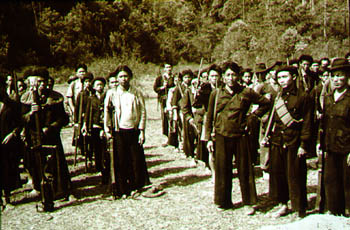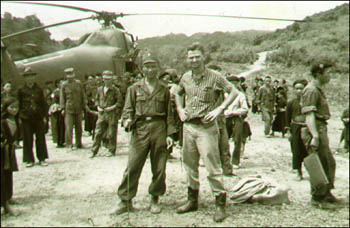
Hundreds of Hmong men fought the Communist forces during the "secret war" in Laos
Part of This Is Home: The Hmong in Minnesota
Born in 1925, Ly Xiong Pao was one of many Central Intelligence Agency-trained Hmong who fought against communist forces and rescued downed American pilots. Ly, who grew up in a small city in Laos and attended school through third grade, speaks Hmong, Laotian, and French. He was a government administrator and soldier in Laos before his CIA training. Early on, in 1960, Ly and a group of soldiers fought a battle in Xieng Kouang Province.
Ly: My group consists of civilians and soldiers - 195 people. We only have 27 weapons. We went there during the nighttime, and we got there at 4 o'clock in the morning. We were trying to take over the airport, and trying to take over the munitions there, and trying to take over the work place and factory.
During that time the Laotian soldiers were the security there. But then the leader, military leader, was not there. When we took over, we told the soldier there "we are here to give you freedom and give you economic wealth, not to kill you."
A few months later, American airplanes dropped the first of many weapon shipments for the Royal Lao Army and Hmong soldiers. The war ended in 1975. As communist forces took control, Ly helped others find their way out of Laos. Four years later, Ly left Laos forever and fled to a refugee camp. He stayed there two years and then moved to Europe and later, South America.
Ly: The reason I went to France and French Guiana and my kids to the United States was that, by law, polygamy is practiced and I have three wives, and I have 32 children - 11 sons and 21 daughters. When I registered to come to the United States, they wouldn't accept me because I practice polygamy.
And then we lived in Cacao, in French Guyana. And then French law said one person can only marry to one person. And then I divorced two of my wives and then keep one. I decided to divorce the ones that have older children that can take care of them. And keep the one who has younger children who needs my support.
Ly Xiong Pao has lived in Saint Paul now for 10 years. Photographs and posters of Hmong leaders adorn the walls inside his home. Ly, now an old man, is a Hmong clan leader and shaman. A traditional shaman's shrine stands against one wall. Draped across the ceiling is a xa neng, two wooden dowels with four pieces of wire tied from end to end.
more
http://news.minnesota.publicradio.org/features/199903/08_nymanl_home/portraits/pao.shtml
General Vang Pao (left), while still a young lieutenant, standing next to Air America pilot Fred Sass in 1961. The CIA contracted with Air America to provide support for the Hmong troops